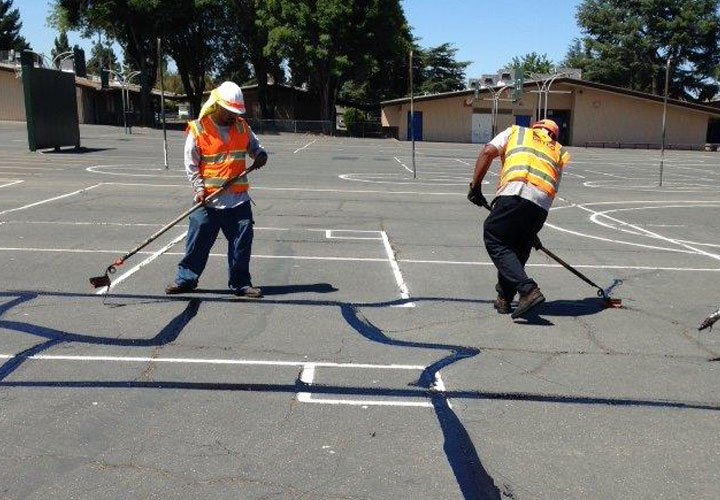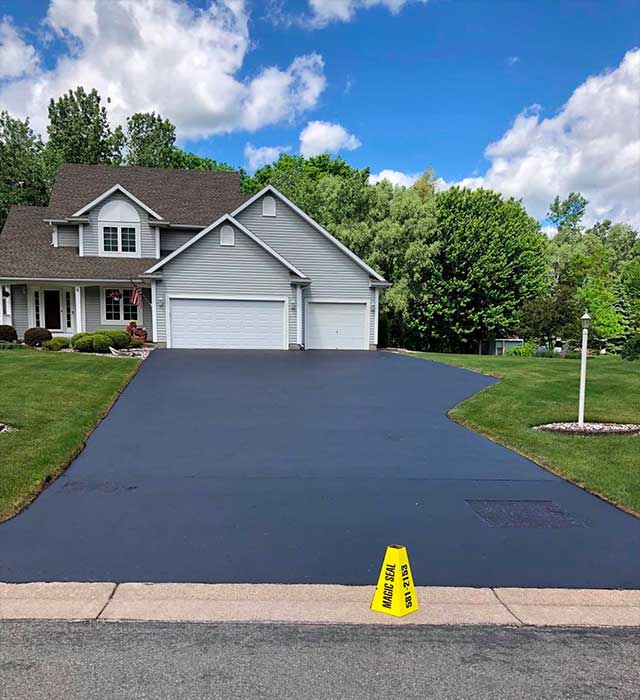Change Your Home's Looks: Commercial Parking Area Leading and Asphalt Sealing Solutions
Change Your Home's Looks: Commercial Parking Area Leading and Asphalt Sealing Solutions
Blog Article
Warm Mix Asphalt: A Sustainable Solution for Sidewalk
Warm Mix Asphalt (HMA) has become a leading lasting selection for pavement services, providing a myriad of ingenious modern technologies and ecological advantages. Its capability to recycle products and decrease power consumption offers an engaging case for its adoption in road building and construction jobs. In addition, the lasting performance and toughness of HMA make it a recommended alternative for facilities advancement. As the need for eco-friendly building and construction methods grows, discovering the nuances of HMA's sustainability can offer important understandings right into the future of sidewalk services.
Ecological Benefits of Warm Mix Asphalt

In Addition, Warm Mix Asphalt aids to alleviate urban heat island impacts. Its dark shade soaks up sunshine, reducing the quantity of heat mirrored back into the environment contrasted to lighter-colored pavements. This can lower ambient temperature levels in metropolitan areas, reducing the need for cooling and inevitably reducing power consumption.
On top of that, Hot Mix Asphalt adds to enhanced stormwater management. Its permeable nature permits water to charge and penetrate the sidewalk groundwater products, reducing overflow and the risk of flooding. These environmental benefits make Hot Mix Asphalt a sustainable option for paving roads and freeways.
Power Performance in HMA Manufacturing
Is energy effectiveness a critical element in the manufacturing of Warm Mix Asphalt (HMA)? Energy plays a significant duty in the production of HMA, impacting both price and environmental sustainability. One crucial aspect of power effectiveness in HMA manufacturing is the usage of cozy mix asphalt (WMA) innovations.
Moreover, innovations in plant modern technologies have actually resulted in more energy-efficient HMA production processes. Modern plants are made with features like recycled asphalt pavement (RAP) handling capacities, efficient burner systems, and improved insulation, all adding to power financial savings. By maximizing power usage in HMA production, the industry can lower its carbon impact while maintaining high-grade sidewalk products. Energy effectiveness is, for that reason, a crucial consideration in guaranteeing the sustainability of Hot Mix Asphalt production.
Recyclability of Hot Mix Asphalt
The recyclability of Hot Mix Asphalt (HMA) is a critical aspect of its sustainability and long-lasting environmental influence. HMA is just one of the most recycled materials in the USA, with over 100 million lots of redeemed asphalt sidewalk (RAP) being recycled every year in brand-new sidewalk construction. Recycling HMA offers numerous environmental advantages, such as decreasing the demand for virgin products, lowering power intake throughout production, and lowering the quantity of waste sent to garbage dumps.
The procedure of reusing HMA includes milling the existing sidewalk, squashing it web right into smaller sized pieces, and mixing it with brand-new aggregate and asphalt binder click for source to create a recycled mix. This recycled mix can commonly execute as well as and even much better than standard HMA, while requiring less resources and generating lower greenhouse gas exhausts. By incorporating RAP into brand-new sidewalk projects, roadway agencies can preserve natural deposits, reduce expenses, and decrease the environmental footprint of road building and upkeep tasks. On the whole, the recyclability of HMA plays a considerable role in advertising sustainable techniques within the sidewalk industry.

Long-Term Performance of HMA
Asphalt pavements show sturdiness and durability over a prolonged duration, showing the long-lasting efficiency of Warm Mix Asphalt (HMA) The durability of HMA can be connected to its capability to hold up against hefty traffic lots, severe weather, and the effects of aging. Researches have actually shown that well-designed and properly constructed HMA pavements can last for two decades or more with routine upkeep. The key to making best use of the long-lasting efficiency of HMA exists in making use of high-grade products, following ideal techniques in building and construction, and implementing efficient maintenance methods. Correct water drainage, regular assessments, and timely repair work are important for maintaining the structural honesty of HMA pavements with time. In addition, developments in HMA innovation, such as the use of polymer-modified binders and warm mix asphalt, have additionally improved the resilience and long life of HMA sidewalks. By focusing on high quality construction and upkeep techniques, HMA remains to confirm itself as a sustainable and economical option for lasting pavement framework.

HMA: Durability and Sustainability
Demonstrating both resilience and sustainability, Warm Mix Asphalt (HMA) has actually become a keystone in the construction of resilient pavement infrastructures - commercial parking lot paving. HMA's longevity originates from its capability to hold up against hefty loads, severe weather problems, and high web traffic volumes, making it a trustworthy option for roads, freeways, and airport terminal paths. The structure of HMA, which commonly check out this site consists of accumulations, binder, and filler, plays a crucial role in enhancing its longevity and resistance to use and tear
Moreover, HMA's sustainability lies in its recyclability and energy-efficient manufacturing process. The ability to recycle recovered asphalt pavement (RAP) in new HMA combinations minimizes the demand for virgin products and reduces the ecological effect of pavement building and upkeep. Additionally, the power efficiency of producing HMA hinges on its lower mixing temperatures compared to other sidewalk products, causing decreased power usage and greenhouse gas emissions.
Conclusion
To conclude, warm mix asphalt (HMA) provides a lasting solution for sidewalk with its ecologically friendly attributes. HMA's recyclability, energy efficiency in manufacturing, and lasting longevity make it an environment-friendly choice for road building. By conserving natural deposits, lowering waste, and lowering greenhouse gas discharges, HMA plays an important role in advertising sustainability in facilities advancement. Its capacity to mitigate city warm island impacts further highlights its value in developing durable and ecologically aware sidewalk systems.
HMA is one of the most recycled materials in the United States, with over 100 million bunches of recovered asphalt pavement (RAP) being recycled every year in brand-new sidewalk construction.The process of recycling HMA includes crushing the existing pavement, crushing it right into smaller items, and mixing it with new aggregate and asphalt binder to develop a recycled mix.Asphalt pavements show longevity and resilience over an extended period, reflecting the lasting performance of Warm Mix Asphalt (HMA) Furthermore, improvements in HMA innovation, such as the usage of polymer-modified binders and cozy mix asphalt, have further enhanced the longevity and durability of HMA sidewalks. The capacity to reuse recovered asphalt pavement (RAP) in new HMA mixes decreases the need for virgin materials and reduces the environmental effect of sidewalk construction and upkeep.
Report this page